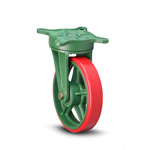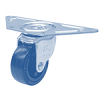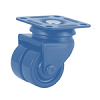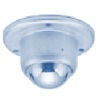(!) Since support from Microsoft will end on January 14th, 2020, Windows 7 will be excluded from the recommended environment from December 15th, 2019 on this site. Vì lý do Microsoft kết thúc hỗ trợ cho Windows 7 vào ngày 14/01/2020, Windows 7 sẽ là hệ điều hành không được khuyến khích sử dụng với trang web này từ ngày 15/12/2019.
Search by Category / Brand Tìm theo danh mục, nhãn hiệu
Search by Category Tìm theo danh mục
- [Thông báo] Cập nhật địa chỉ kho tập kết hàng hóa tại khu vực miền Nam của MISUMI Việt Nam. Xem chi tiết.
[Announcement] Update on warehouse address in the Southern region of MISUIMI Vietnam. See more. - [Cảnh Báo] Thủ Đoạn Lừa Đảo Từ Nhân Viên Giao Hàng – Yêu Cầu Trả Phí Ship. Xem chi tiết.
[Warning] Fraud Calling from Shipper - Asking to Pay Shipping Fee. See more.
Casters(Mounting Hole Pitch, Short Length Direction W1:112(120))
Brand |
|
|---|---|
| CAD |
|
| Days to Ship |
|
1 itemsMặt hàng
- Sort By
-
You can add up to 6 items per a category to the compare list.

Duct Tile Caster, Pulley Caster, SR
TOUHOKU SHARYO
A ductile (cast) caster designed for automatic towing. Suitable for automatic transport, features light swivel torque, as well as light movement. Wheel materials can be selected depending on the application and load.[Features]· A thrust bearing is used for the swivel part.· A ball bearing is used for the base center axle part.
- CAD :
- 2D
Mounting Height H(mm) Type Caster Type Load Range(daN) Wheel Dia. D(Ø) Stopper (Detail) Wheel Material Fitting Material Mounting Hole Pitch, Short Length Direction W1(mm) Mounting Hole Pitch, Long Length Direction L1(mm) Thread Dia. Wheel Characteristics Mounting Hole Pitch Circular Diameter(mm) Mounting Hole Type 250 - Plate Type Swivel 485.01~750.00 / 750.01~ 200 - Nylon / Steel Steel 112(120) 112(120) - Abrasion Resistance / Gasoline Resistant (including Light Oil) / Oil Resistance / Chemical Resistance / Heat Resistance / Low Temp. Resistance / Antistatic - Slotted Hole From: 4,153,285 VND Days to Ship: Số ngày giao hàng: 8 Day(s) or more  8 Day(s) or more
8 Day(s) or more
| BrandNhãn hiệu |
|---|
| Product SeriesDòng sản phẩm |
| CADCAD |
| From |
| Days to ShipSố ngày giao hàng |
| Mounting Height H(mm) |
| Type |
| Caster Type |
| Load Range(daN) |
| Wheel Dia. D(Ø) |
| Stopper (Detail) |
| Wheel Material |
| Fitting Material |
| Mounting Hole Pitch, Short Length Direction W1(mm) |
| Mounting Hole Pitch, Long Length Direction L1(mm) |
| Thread Dia. |
| Wheel Characteristics |
| Mounting Hole Pitch Circular Diameter(mm) |
| Mounting Hole Type |
You can add up to 6 items per a category to the compare list. | |
| BrandNhãn hiệu | TOUHOKU SHARYO |
| Product SeriesDòng sản phẩm | |
| CADCAD |
|
| From | 4,153,285 VND |
| Days to ShipSố ngày giao hàng | 8 Day(s) or more |
| Mounting Height H(mm) | 250 |
| Type | - |
| Caster Type | Plate Type Swivel |
| Load Range(daN) | 485.01~750.00 / 750.01~ |
| Wheel Dia. D(Ø) | 200 |
| Stopper (Detail) | - |
| Wheel Material | Nylon / Steel |
| Fitting Material | Steel |
| Mounting Hole Pitch, Short Length Direction W1(mm) | 112(120) |
| Mounting Hole Pitch, Long Length Direction L1(mm) | 112(120) |
| Thread Dia. | - |
| Wheel Characteristics | Abrasion Resistance / Gasoline Resistant (including Light Oil) / Oil Resistance / Chemical Resistance / Heat Resistance / Low Temp. Resistance / Antistatic |
| Mounting Hole Pitch Circular Diameter(mm) | - |
| Mounting Hole Type | Slotted Hole |
Loading...Tải…
ConfigureTạo
Specification/DimensionsĐặc điểm kỹ thuật / Kích thướcĐặc điểm kỹ thuật / Kích thước
-
Mounting Height H(mm)
- 12.5
- 21
- 23.5
- 30
- 32
- 34
- 35
- 36
- 39
- 42
- 42.5
- 43
- 43.5
- 44
- 44.5
- 45
- 46
- 46.5
- 47
- 48
- 49
- 50
- 50.5
- 51
- 51.5
- 52
- 53
- 54
- 54.5
- 55
- 56
- 57
- 57.5
- 58
- 58.5
- 59
- 59.5
- 60
- 61
- 62
- 63
- 63.5
- 64
- 65
- 65.5
- 66
- 67
- 68
- 68.5
- 69
- 70
- 70.5
- 71
- 72
- 72.5
- 73
- 74
- 74.5
- 75
- 76
- 77
- 77.5
- 78
- 79
- 79~72
- 79.5
- 80
- 81
- 82
- 83
- 84
- 84.5
- 85
- 86
- 87
- 87~75
- 87.5
- 88
- 89
- 89~77
- 90
- 91
- 92
- 92.5
- 93
- 94
- 95
- 95.5
- 96
- 96.5
- 97
- 98
- 99
- 99.5
- 100
- 101
- 102
- 102.3
- 102.5
- 103
- 104
- 105
- 105mm
- 105.5
- 105.8
- 106
- 107
- 108
- 109
- 110
- 111.5
- 112~100
- 112.5
- 113
- 113mm
- 114
- 114~102
- 115
- 116
- 117
- 117.5
- 118
- 119
- 120
- 121
- 122
- 123
- 124
- 124.5
- 125
- 126
- 126.4
- 126.5
- 127
- 128
- 129
- 129.3
- 130
- 130mm
- 130.5
- 132
- 132.5
- 133
- 133.5
- 134
- 135
- 136
- 137
- 137~125
- 138
- 139
- 139~127
- 140
- 141
- 142
- 143
- 144
- 144mm
- 145
- 148
- 150
- 151
- 152
- 152.4
- 152.5
- 153
- 153~145
- 153.5
- 154
- 155
- 155mm
- 155.5
- 156
- 157
- 158
- 159
- 160
- 161
- 162
- 163
- 164
- 165
- 165(142)
- 166
- 168
- 168.5
- 170
- 171~148
- 171~154
- 171~158
- 173
- 175
- 176
- 177
- 178
- 178.5
- 179
- 180
- 182
- 183
- 184
- 184.5
- 185
- 185 to 205
- 185.5
- 186
- 186(161)
- 186.6
- 187
- 188
- 190
- 190.5
- 191
- 192
- 193~167
- 193~173
- 193~177
- 193 to 183
- 194
- 195
- 196
- 196.6
- 198
- 199.5
- 200
- 202
- 203
- 204
- 205
- 210
- 210~198
- 213
- 214
- 217
- 217.5~337.5
- 219
- 220
- 225
- 230
- 230 to 250
- 235
- 236
- 237
- 239.5
- 240
- 241
- 244
- 245
- 246 to 236
- 247.3
- 248
- 250
- 250~235
- 251
- 252
- 255
- 256
- 257
- 260
- 260~250
- 267
- 270
- 272~392
- 275
- 275~255
- 275~260
- 285
- 287
- 289
- 290
- 292
- 293
- 300
- 302
- 304
- 305
- 306
- 308
- 312
- 315
- 317
- 320
- 330
- 350
- 353
- 355
- 360
- 365
- 367
- 370
- 371
- 374
- 375
- 378.5
- 394
- 460
-
Type
- Caster
-
Caster Type
-
Plate Type Swivel

-
Plate Type Fixed

-
Screw-In Type

-
With Shock Absorber

-
With Leveling Mounts

-
Plug-In Type

-
Resin

-
Through Hole Type

-
Angle Type

-
Others

-
Related Components

-
Corner Caster

-
Dual Wheels

-
Plate Type Ball Caster

- Rotation Type
- Rotation Brake Type
-
Plate Type Swivel
-
Load Range(daN)
- ~35.00
- 35.01~80.00
- 80.01~140.00
- 140.01~220.00
- 220.01~320.00
- 320.01~485.00
- 485.01~750.00
- 750.01~
-
Wheel Dia. D(Ø)
-
Stopper (Detail)
- Not Provided
- With Rotation Stopper
- With Swivel Stopper
- With Double Stopper (Rotation + Swivel)
-
Wheel Material
- Synthetic Rubber
- Nylon
- Urethane
- Polyurethane
- Phenol
- Engineering Plastics
- Steel
- Others
- Stainless Steel
- Rubber
- Elastomer
- Injection urethane
-
Fitting Material
- Steel
- Stainless Steel
- Others
- Aluminum
- Steel
- Zinc
-
Mounting Hole Pitch, Short Length Direction W1(mm)
-
Mounting Hole Pitch, Long Length Direction L1(mm)
-
Thread Dia.
-
Wheel Characteristics
-
Mounting Hole Pitch Circular Diameter(mm)
-
Mounting Hole Type
Related Categories to CastersDanh mục liên quan đến Casters
FAQ Casters
- Question: How do you choose the right castor wheels for a particular application?
- Answer: Essential points to consider before choosing the right casters consist ofEssential points to consider before choosing the right casters consist of
1. Load Capacity: Determine the maximum weight the castor wheels will need to support. It is crucial to choose wheels with a load capacity that not exceeds the specification to ensure safety and longevity.
2. Wheel Diameter: The size of the wheels affects maneuverability and stability. Larger wheels roll more easily over uneven surfaces and obstacles, but they may require more space. Smaller wheels may not perform as well on rough surfaces.
3. Wheel Material: Consider the type of floor or surface the wheels will encounter. Different materials are suitable for various applications. For example: Rubber, Polyurethane, Nylon, Steel and so on
4. Wheel Type: Depending on the application, you may choose from different wheel types, such as: Swivel wheels, Fixed wheels or other option like a foot brake system
5. Environment: Consider the operating environment and conditions. For example: Indoor or outdoor, rough surfaces, in a manufacturing environment like a electronic industrial
- Cleanroom or healthcare settings: Castor wheels for these environments need to meet specific cleanliness and hygiene standards.
6. Mounting Options: such as plate mount, stem mount, or bolt hole mount and so on - Question: What are some common materials used in the manufacturing of caster wheels?
- Answer: 1. Rubber: its high durability, shock absorption, and non-marking properties.
2. Polyurethane (PU): This caster’s material is often used in industrial settings where heavy loads or uneven surfaces are common.
3. Nylon: This caster’s material is commonly used in industrial and commercial applications. Nylon wheels are also non-marking and have good resistance to chemicals and solvents.
4. Cast iron: They are commonly used in industrial applications where high load capacities and durability are required. However, cast iron wheels can be noisy and are not suitable for delicate or smooth floor surfaces.However, cast iron wheels can be noisy and are not suitable for delicate or smooth floor surfaces.
5. Steel: Steel wheels also can withstand heavy loads. They are often used in industrial settings where extreme conditions, such as high temperatures or harsh environments.However, steel wheels can be noisy and are not suitable for delicate or smooth floor surfaces. - Question: What are the differences between chair casters and heavy-duty industrial wheels?
- Answer: Here are some key differences between chair casters and heavy-duty:
1. Load Capacity:
Chair casters: can support only the weight of the person
Heavy-duty: can support the weight of machinery and other equipment
2. Materials :
Chair casters made of lighter materials like nylon, rubber, or polyurethane, and so on.
Heavy-duty caster made of cast iron or steel, so it cannot carry a lot of loads
3. Floor Protection:
Chair casters are designed to be floor-friendly, with no any mark on the floor
Heavy-duty casters sometimes can make a mark on the floor - Question: What are some features of heavy-duty casters that make them suitable for industrial applications?
- Answer: Here are some features that make heavy-duty casters suitable for such environments:
1. Load Capacity: Heavy-duty casters are designed to support and transport substantial weight capacities. They have higher load ratings compared to standard casters
2. Robust Construction and wheel materials: Heavy-duty casters are built with durable and strong materials to withstand the rigors of industrial environments. Common materials used include steel, cast iron and stainless .Moreover, the wheel material for example Nylon, Polyethylene or reinforced polymers.
3. Large Wheel Diameter: Heavy-duty casters often feature larger wheel diameters, which provide several advantages. Larger wheels can roll more easily over uneven surfaces. They also distribute the load over a larger area
4. Bearing Type: Heavy-duty casters are often use ball bearings or precision tapered roller bearings are commonly used to handle heavy loads
5. Locking System: Many heavy-duty casters come with locking mechanisms to secure the wheels in place when needed. These brakes or locks prevent unintended movement and increase safety provide stability during loading, unloading, or stationary applications.
6. Shock Absorption: Some heavy-duty casters are designed with shock-absorbing features to minimize vibrations and impacts during transportation.




















How can we improve?
How can we improve?
While we are not able to respond directly to comments submitted in this form, the information will be reviewed for future improvement.
Customer Privacy Policy
Thank you for your cooperation.
While we are not able to respond directly to comments submitted in this form, the information will be reviewed for future improvement.
Please use the inquiry form.
Customer Privacy Policy